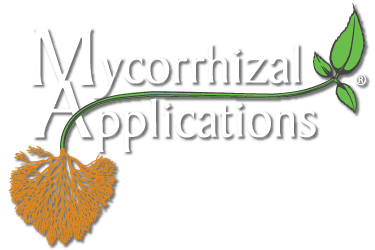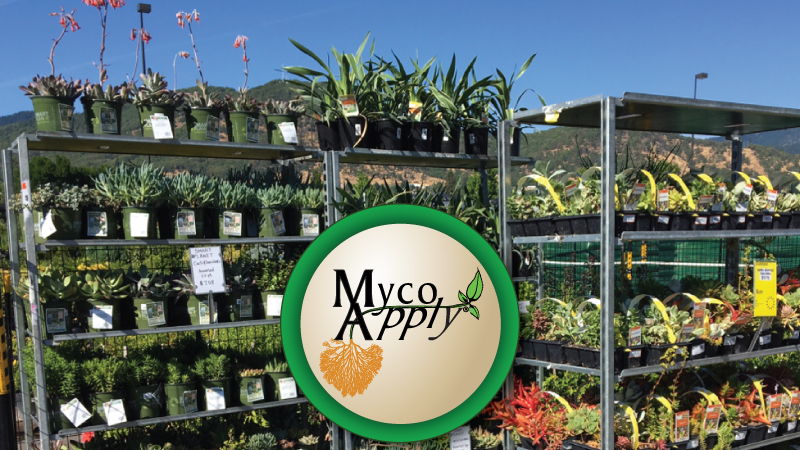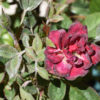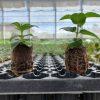The many benefits that mycorrhizal fungi provide to plants are extremely well documented. In fact, mycorrhizal fungi have been called the most researched soil organisms in the world, with scholarly journal articles and published trials from countries around the globe numbering in the tens of thousands. These symbiotic organisms have been relied upon for successful reforestation and restoration projects for decades. In agriculture, mycorrhizal fungi are partnering with plants in symbiosis to contribute to sustainably feeding our growing global population, even in drought affected areas, salty soils, desertified farmland, etc.
Professional horticulturists, including greenhouse and nursery growers, can also experience the benefits of mycorrhizae in their own growing protocols. However, these benefits can sometimes be harder to demonstrate in horticultural circumstances, since plants are less likely to experience stress in a greenhouse or nursery, as the growers are giving them everything that they should need to thrive, including plenty of water and nutrients. Most ornamental plants will show some additional growth as well as improved root structure and plant habit when inoculated with mycorrhizal fungi, even within the short turnaround time that greenhouse or nursery growers will have their plants in production. However, when comparing mycorrhizal treated plants with non-treated controls in the greenhouse, these differences may not always look like they will impact the bottom-line. But, as soon as these treated plants leave the grower, this is where the benefits of mycorrhizal inoculation really begin to shine, and these benefits positively reflect back to the grower.
Increase Plant Resilience in Transport and Retail:
Ornamental plants are delicate beauties. They are babied from the time of propagation, and ideally, are provided with the perfect environment to optimize growth and development. Before heading out into the world for retail sale or landscape installation, they will certainly be watered to prepare for the journey, but this may be the last water they see until reaching their destination. The stress of being packed into a dark truck on crowded racks, with the potential for extreme heat or cold and little or no air movement, may be their first shock and can have an impact on how they look on the retail shelf.
Then, once they make it to the garden center, box store, etc., they are handed off to a new situation and staff who may or may not be capable of continuing to providing those ideal conditions that the plants had become accustomed to. The heat and drought of a retail situation can cause a good deal of plant wilt, blossom and foliage damage, and even mortality, making them less and less likely to be chosen by a homeowner or landscaper off the shelf. This is where the inoculated plants really start to stand out, as they are more resilient and will resist wilt for 24-48 hours longer than untreated plants, and will recover from wilt much more quickly once the staff gets the chance to make the rounds. This means higher sell-through for “pay by scan” growers, and fewer dumped or discounted plants, which is a good thing for everyone in the pipeline. For the grower retailer, mycorrhizal inoculation means that your plants will look better in the shop, survive longer on the shelf, and ultimately improve the customer experience with your brand, as end-users will experience less transplant shock, less mortality, and greater overall success and satisfaction with your mycorrhizae inoculated plants. Also, any retailer that has a plant guarantee will see less loss at transplant and fewer returned plants, which reduces the costs for the retailer and grower of guaranteed plants.
Benefits to Home Gardeners and Landscapers:
The benefits of mycorrhizal fungi to plant resilience, longevity, vitality, and overall performance are passed along from the grower to the end-user, whether it happens to be a home gardener or landscaper. Home gardeners, especially inexperienced “casual” gardeners, will have more success in the garden with less effort, leading to return trips to the retailer and additional purchases. And this is good for the grower and retailer as well, because when home gardeners have success, they will likely return to that same nursery or retailer for more of those “good” plants that they had so much success with. The same concept applies to landscape professionals, who will certainly return to the source of those resilient, hearty plants that they only had to plant once, rather than having to return to a site to replace plants that didn’t successfully take root and survive in outplanting. Plus, the landscaper’s customers will be happier, as their plants will be more sustainable, lower maintenance, and require fewer inputs such as water and nutrients to survive and thrive.
How Soon Will You See the Benefits?
The general benchmark is that it may take as long as 8 weeks to see a visible difference between mycorrhizal inoculated plants and untreated control plants, however, this varies quite a bit from species to species, with some plants showing significant differences as soon as 2-3 weeks after treatment. As a plant producer, you will see bigger benefits of mycorrhizal inoculation if you also reduce your nutrient inputs when inoculating with mycorrhizal fungi. This not only offers the immediate benefit of offsetting some of the costs of the mycorrhizal product, but it also leads to quicker and more effective colonization of the root zone, since plants who are over-fertilized will send out fewer root exudates to trigger the germination of the mycorrhizal propagules. We recommend cutting back on fertilizer by around 30-40% when inoculating with mycorrhizal products like MycoApply, in order to maximize the return on investment, and reap the full rewards of the symbiosis.
Also, the earlier in the plant’s life cycle that you can inoculate the roots, the better. If the grower can include mycorrhizal inoculants in the growing media at plug stage, or drench the propagation trays in a mycorrhizal slurry, this is the most cost-effective method, and can provide the plant with this symbiotic support for the rest of its life. The basic guideline is this: the smaller the plant at the time of inoculation, the less product you will need to achieve mycorrhizal colonization. Simple, right? When inoculating at propagation stage, the cost can be as low as $0.03 to $0.04 cents per plug tray!
For a landscaper, or a retailer who does landscape installation, inoculation at plug stage may not be possible, however, these products work very well in transplanting as well. Mycorrhizal Applications offers MycoApply products in powder formulations (such as MycoApply Ultrafine Endo), which can be drenched or applied directly as a powder to root balls during transplant, as well as granular formulations (such as MycoApply Endo), which can be applied around the exposed roots and incorporated into transplant backfill. No matter the stage of the plant’s lifecycle, any time you can get the mycorrhizal propagules into contact with the growing roots, you can kick-off the symbiotic colonization process.
Where can I find these products and learn more about how to use them?
MycoApply professional mycorrhizal inoculants are available through many nationwide distributors. The best way to determine where you can get your hands on some to try in your own greenhouse or nursery is to contact Mycorrhizal Applications, who can then point you towards a distributor in your region. Their information is available online at mycorrhizae.com, or you can reach one of their helpful, friendly, and passionate sales staff by calling (541) 476-3985 or emailing inquiries@mycorrhizae.com. They also have access to a library of research and resources about how to utilize this technology, so feel free to reach out with any mycorrhizal questions that could help you maximize your success.
© 2017, by Mycorrhizal Applications LLC







